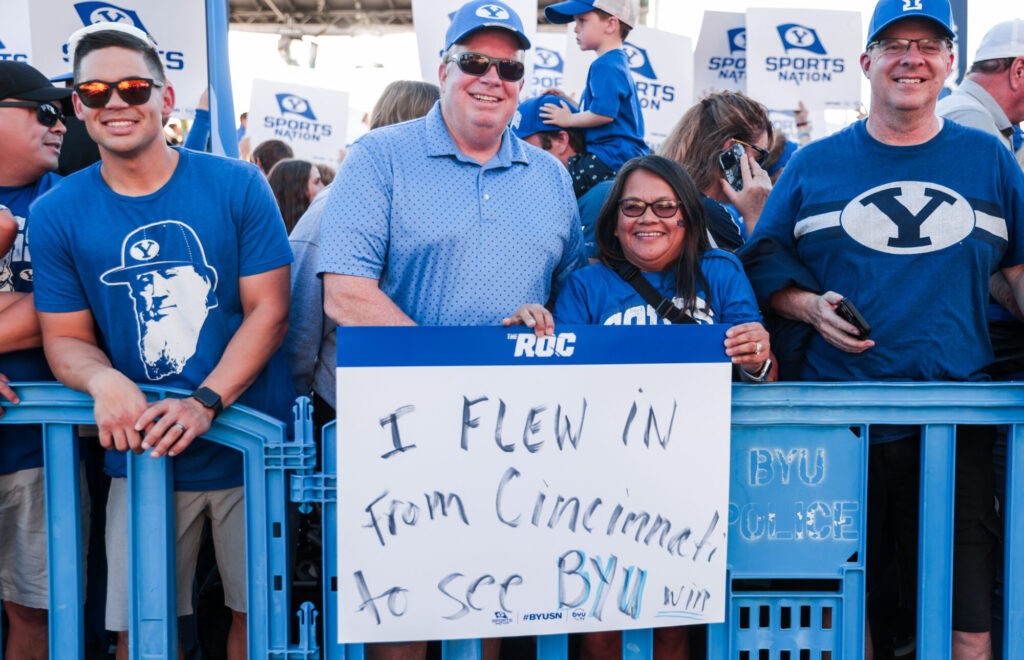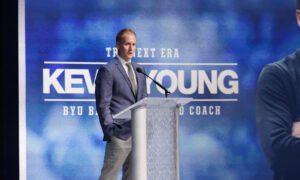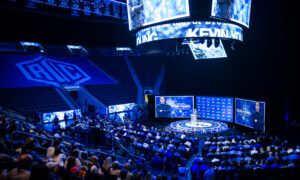
Two fans hold up a sign before BYU played its first Big 12 home game in school history. – BYU Athletics & BYU Photo.
By Jeff Fuller
Bob Thompson, former President of Fox Sports Networks and co-founder of the Big Ten Network, was recently asked by “The Holy Rivals” YouTube show: “Beyond TV viewership, what other data points would a media company consider that matters in realignment that’s going to drive [value]?”
He replied: “… beyond [viewership] you look at the reach of the alumni group. That’s one of the things about the Big10 schools; those are all huge schools, and so that means they all have a huge number of graduates and those graduates are all over the country. They may go to Michigan for school, but they move to NY or Chicago or Dallas or wherever to ultimately pursue their careers. So the fact that it had a wide reach in terms of alumni support is very important and something the Big10 has always talked about. Delaney used to always quote to me the number of Big10 graduates in SoCal. So that’s an important one. I think you also look at internal rivalries that really move the needle… “
The hosts followed up with: “Why is it important to have a lot of alumni in a big market if we’re all talking about TV Viewership nationwide… why would that be valuable to a media company?”
“It’s valuable to the media company because then they can drive (advertising) prices in those markets and not just in the market that has the school located within it.”
My ears perked up at that revelation, as it independently confirmed information I received a few months ago claiming that BYU had a higher media value than two-thirds of P5 programs, surprisingly placing Cougar football around 20th nationwide. A main reason cited by this source was the widespread nature of BYU Alumni/fans within important media markets.
This source claims to have seen internal documents from ESPN a few years ago. When he questioned why BYU was somewhat higher than expected based on raw viewership numbers he received the following explanation and share it with me:
“Most of our own fans don’t even want to believe that (BYU is around 20th nationally in media value) for multiple reasons. One of the biggest reasons is everyone gets caught up in one particular misleading stat, TV Viewership.
“Raw TV Viewership is only one part of the equation when it comes to a CFB Team’s media value. Apart from the top 12 (maybe 15) power programs, TV Viewership can be very misleading (strongly influenced by such variables as opponent, whether or not either team is ranked, time/channel window, competing games on other channels, lead-in programming, game competitiveness, rivalries/storylines, national impact of game result, etc…)
“Advertising $$ is a massive part of the equation that most people simply do not understand.
“If I were to ask most CFB fans: ‘Which game is more valuable to ESPN or Fox… a ASU v Oregon St. matchup that draws 2.4 Million viewers or a BYU v Wash St game that draws 1.9 Million?’ most CFB fans would immediately pick the ASU v Oregon St matchup. And in most cases they would be right, but not when BYU is a part of the equation.
“The overwhelming majority of CFB games fall into the same category when it comes to selling advertising. Most CFB games the advertising $$ are sold as REGIONAL advertising $$.
“When BYU plays, for most of their games, similar to a handful of programs in CFB, the advertising is sold at a higher price/tier as NATIONAL advertising. The reason BYU is sold at the higher national rate? Because of BYU’s national fan base, broadcasters like ESPN and FOX can guarantee their advertising customers the BYU game will draw significant viewership, (more than 10,000 households), in at least 12 and in many cases 20 of the 50 largest media markets in the U.S.
“At most, 10% of CFB programs have as widespread and far reaching fan base as BYU. This simple fact means a lot of additional guaranteed revenue/game for media partners that only a handful of CFB programs can deliver.”
As further confirmation of the importance of having a widespread alumni base, BYU’s current AD, Tom Holmoe, at Big12 Media Days told YouTube host John Kurtz that BYU’s large and widespread alumni/fan base brings value to the Big12.
When Kurtz asked: “What are the things that … (BYU) has to offer to the Big12?”
Holmoe responded:
“When you’re going for an audition in front of the commissioner and their legal counsel … you realize that they’re going to be going to their media consultants and they’re going to be asking ‘what do we need to look for in a team that we want to add to the conference?’ … and those things are:
1) TV numbers
2) how many living alumni do we have and where are they located.
3) what the TV numbers are in different markets
“… we had some great access to numbers through some consultants that, when BYU is on TV up against teams from the Big12 (meaning BYU was playing against a non-Big12 team in the same TV window as Big12 games were going on), that our numbers did really well. This is back in 2016 and I don’t think the Big12 knew that (BYU’s) numbers were that high going up against Big12 teams.”
How many Alumni does BYU have and where do they live?
According to BYU’s most recent data, BYU has about 451K total living alumni. When I compiled “Total Living Alumni” data on all major FBS schools early last year, BYU ranked 15th nationally behind, in order: Penn St, Indiana, Michigan, Michigan St, Arizona St, Texas, Rutgers, Ohio St, Cal, Minnesota, Purdue, UCLA, Illinois, and Florida. As Bob Thompson alluded to above, you can see the preeminence of Big10 as alumni bases go.
This 2017 BYU Alumni report has loads of interesting info including a county-by-county “heat map” of BYU grads per capita.
Other potentially relevant findings of the survey:
- BYU grads aged 40-59 have had an average of 3.9 kids compared to the national average of 2.1 (more viewers-per-TV set and likely more future fans)
- Over half of alumni would attend, or already go, to BYU sporting events, but 23% said they’d only watch BYU sports on TV and another 23% admit to not being interested in sports at all.
A 2016 Deseret News article touting BYU’s case for Big12 inclusion contained the following graphic and quote:
“BYU also has a reputation for drawing large crowds for road games throughout the country.
“‘I think BYU is certainly a national brand, in the same ilk as Notre Dame,’ then-ESPN reporter Joe Schad told the Deseret News in 2012. ‘They have a national recruiting base and a national following.’
“Because of its affiliation with The Church of Jesus Christ of Latter-day Saints, BYU boasts fans across the nation, even among those who didn’t attend the school.
The intersection of Religion and College Football Fan Bases
Regarding this last point, I can speak from personal experience that a sizable percentage of LDS throughout the country who care about college football have BYU as either their first or second favorite team. Fans in Utah are an obvious exception here as many LDS Ute and Aggie fans have no love for BYU as rivals. However, I grew up in Los Angeles, and have lived in many areas that love college football including SLC, Provo, Tuscaloosa, Birmingham, Augusta (Georgia), Iowa City, and Baton Rouge and it’s been my experience that the further you get away from Utah and its neighboring states, the more likely that church members with or without direct BYU ties have a greater affinity towards the church’s flagship school.
This 2021 Church Newsroom release shows a “percent LDS” by state figure:
Data looking at total LDS membership by state shows a heavy presence in the west, but more recent trends towards a growing presence in the midwest and south, especially Texas, Florida, Georgia, North Carolina, Arkansas, Tennessee, and Virginia.
While a solid majority of LDS throughout the nation would not consider themselves BYU football fans, many do. Also, there are enough “low-hanging fruit” among LDS congregations to pick up “new fans” when BYU is doing well in football (possibly similar to some of Notre Dame’s Catholic supporters… though on a smaller scale.)
Speaking of the Fighting Irish, we can see the power of a fan base that stretches far beyond their small-ish alumni network which comes in at a relatively meager 120K. Despite this shortcoming, their unmatched historical football tradition, along with their connection and kinship within the US Irish-Catholic population (which is estimated at ~35M, five times the number of LDS in the US) has made for one of the largest, most resilient, and strongest fan bases in the nation.
Sports media columnist Andrew Marchand has said, on at least two occasions, that Notre Dame has the most media/TV value of any team in the nation. On John Kurtz’s podcast he stated that “Notre Dame is ‘game-changing’ in terms of being worth a lot of money. They’re Notre Dame. They’re the number one team on TV… especially when they’re good.”
In a recent article about Notre Dame’s impending TV-rights negotiations, Marchand opined: “In terms of attractiveness, as for TV, Notre Dame is number one. They’re the Cowboys of college football, the Yankees of college football or whatever analogy you want to make. They’re the Notre Dame of college football.”
While Notre Dame is clearly in the top 10 for total fanbase size, most estimates have Ohio State as the largest followed by Michigan, Penn St, and Texas, with the Irish in the next group including Florida, Alabama, and Texas A&M. So Notre Dame’s superior media value is likely being bolstered by having so many fans all around the nation, guaranteeing advertisers get enough viewers in just about all relevant media markets.
Liberty University presents another interesting case of a religious school quickly rising the ranks of football relevance and fandom due to their ties to Evangelical Christians, with an admission that they’ve looked to BYU as a model.
Summary
Schools like BYU and Notre Dame (albeit on different scales) present media partners with some unique advantages:
- A very low risk/downside due to:
- A “high floor” for baseline viewership based on a core of very loyal fans (Examples for BYU & Notre Dame),
- A widespread fanbase as detailed above, especially in some of the most valuable markets for selling national advertising.
- A potential huge upside in viewership and spike in “new fans” if they make runs at the playoffs by tapping into the low hanging fruit of each religion’s adherents.














